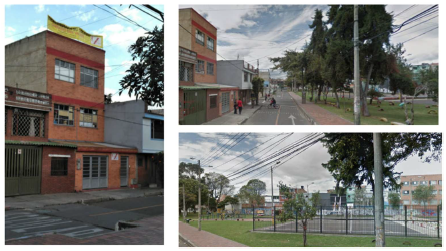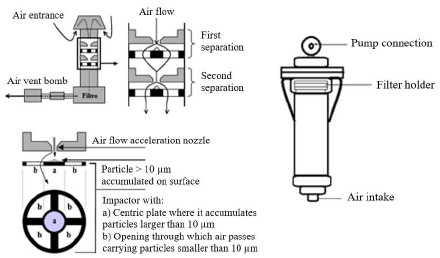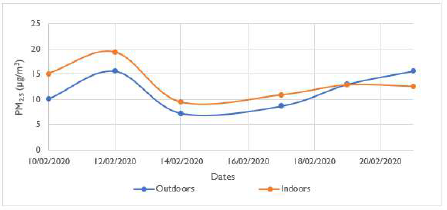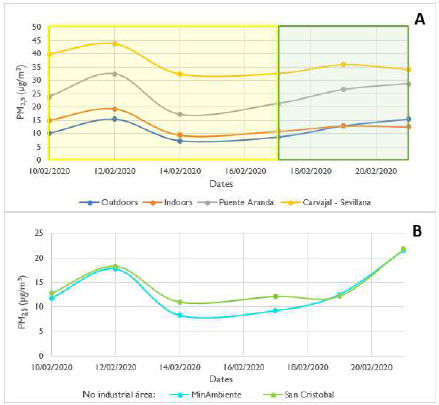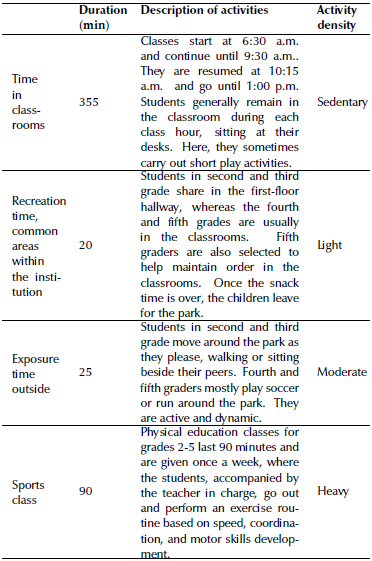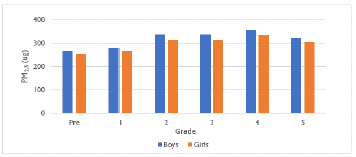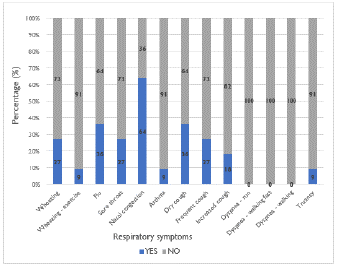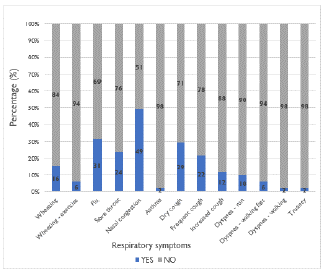Introduction
Air pollution is the world's most considerable environmental risk to human health, according to the World Health Organization (WHO, 2019). It has become a global problem of great importance, which is associated with environmental deterioration and morbidity from respiratory diseases in specific populations such as children, pregnant women, and elderly adults (UNICEF, 2016). In the case of children, vulnerability is dueto their higher breathing rate, lower body mass, and developing immune system (American Academy of Paediatrics, 2004). Fine particles can penetrate deep into the airways and even reach the bloodstream, causing a variety of harmful effects (Oyarzun, 2010). Increases in PM2,5 concentrations are associated with increases in daily and long-term mortality and morbidity (WHO, 2018), and they can entail school absenteeism for children under the age of five in areas of high air pollution. On the other hand, and considering the current situation with regard to COVID-19, scientific studies have shown that air pollution increases the risk of medical complications. In countries such as Italy, France, Germany, and Spain, it is inferred that high concentrations of pollutants in the air could be the most critical aggravating factor of the mortality caused by the virus (Ogen, 2020). Multiple scientific studies worldwide have analyzed schoolchildren's exposure to PM2,5 in order to assess impacts. In China, Chen et al. (2019) determined the exposure of minors to PM2 5 concentrations by gravimetric analysis using a battery-powered mini-sampler, taking samples for 24 hours for two years and evidencing long-term problems in the neuronal, respiratory, and cardiac systems. Likewise, in a study carried out in New Zealand, Bennett et al. (2019) performed measurements of PM2,5 indoors in order to analyze the concentrations and sources of air pollution in a primary school for children between the ages of five and 11 over a period of three weeks, indicating that the main driver of PM2,5 indoors was the infiltration of pollutants, whose main contributor were the by-products of emissions from motor vehicles. On the other hand, in the national context, Franco et al. (2009) characterized the concentration levels of PM10, for district schools located in high traffic corridors of the city of Bogota, obtaining high concentrations of the pollutant inside the institutions, which exceeded the values considered harmful for sensitive populations according to the WHO.
This study aimed to evaluate particulate matter concentrations to which schoolchildren are exposed, as well as the potential inhaled doses that they may receive during their schooling time in an industrial sector of Bogota.
Materials and methods
Sampling site selection
The interest of this study was to evaluate the air quality of a school located within industrial area of the city, in order to assess the levels of PM that students are exposed to. The district of Puente Aranda was designated as an industrial zone since 1974 and became a pole of industrial development in the capital, with an extensive production of plastic, chemicals, textiles, metalworking, beverages, and food, with a large number of industries in the sector. However, its use has been changing, and it has lately become a more commercial and residential area. A number of industrial plants have left the area for other municipalities, especially Mosquera, Funza, Madrid, and Fusagasuga in the outskirts of the city (Bogota City Hall, 2012).
For this study, the sampling sites were located in Gimnasio San Valery, which offers grades from preschool to fifth grade and a total of 103 students with an age range between four and ten. The school is located in a single, three-level building with immediate access to a public park for recreational and sport activities. This school maintains the typical structure of many small private institutions, nowadays common in the city, with a single building containing all academic spaces and using the public parks nearby for sport and leisure activities.
The Puente Aranda and Carvajal-Sevillana stations of the air quality monitoring network (RMCAB) are located 1,9 km north and 3,6 km southwest of the school (Figure 1), respectively. This study used PM2,5 concentrations and wind direction reports from these stations for reference. Data are accessible in the network's website http://rmcab.ambientebogota.gov.co/.
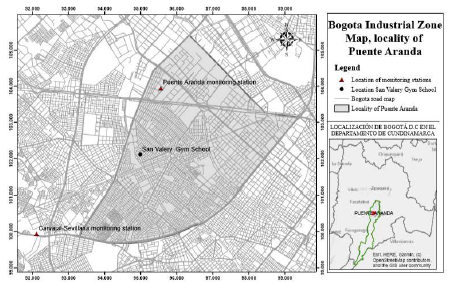
Source: Authors
Figure 1 Location of the sampling site and the Puente Aranda and Carvajal-Sevillana air quality monitoring stations
Data obtained from the RMCAB allowed for a comparison of concentration behaviors with the in situ samplings carried outduringthis research, in ranges of 48 hours corresponding to the same sampling times.
In the surroundings of the sampling site (Gimnasio San Valery School, Figure 2), there is a road axis with circulation of collective public transport, as well as abundant adjacent industries outside a radius of 1 km. In the district, the landscape is predominantly industrial, with warehouses, factories, and large houses established for commerce and services.
A green zone in the area corresponds to the Camelia neighbourhood park, located in front of the school, an area used daily as a rest area, as well as for recreation and school activities, as seen in Figure 2.
Estimation of potential doses inhaled and inhalation rates
To calculate the potential dose inhaled by age range and gender, the following relationship was used:
where the potential dose is in µg, PM2,5 denotes the particulate matter concentration (µg/m3), the venilation rate is in m3 /min, and t is the exposure time by exertion level (min).
As a method to calculate the inhalation rate and obtain statistical data regarding human exposure to environmental agents, the EPA Exposure Factors Handbook was used as a reference document (EPA, 2011), which provides inhalation rates with descriptive statistics for the average ventilation rate (m 3 /min), based on variables of gender and age range for activities of diverse exertion levels.
Sedentary and passive activities are defined as sitting and standing; light intensity activities as walking at a speed between 0,7 and 1,3 m/s; moderate intensity activities as fast walking (between 1,4 and 1,8 m/s) and slow running (between 1,6 and 1,8 m/s); and high intensity activities are defined as fast running (between 2,0 and 2,7 m/s).
Through a rubric, the activities performed by the students and their times were collected, in order to establish a relationship with the inhalation rates and the duration of such events. The activities considered in this study were class time, recess time in common areas (indoors), and outdoor sports activities.
PM 2,5 mass concentrations
Particulate matter concentrations were determined during school days for sampling periods of 48 hours over a two-week sampling campaign. Indoor and outdoor PM2,5 sampling was performed using two low-volume area samplers (Chemcomb 3500) (Figure 3) and 37 mm, 2 microns pore Teflon filters (Whatman, GE Healthcare). The filters were weighed before and after sampling using a Sartorius analytical balance (M5P-000V001), after conditioning in a desiccator at 23 °C and 45% relative humidity for 24 hours.
Respiratory symptoms in children
A survey was conducted to characterize children's respiratory symptoms, which was based on the ISAAC questionnaire (International Study on Asthma and Allergies in Childhood) and its adaptation in Colombia, i.e., Validation of the Spanish version of the ISAAC phase III questionnaire on asthma (Mata-Fernandez et al., 2005), which collected information on intramural and extramural factors, referring to the existing conditions both in Gimnasio San Valery and at the students' homes.
Results and discussion
PM2,5 concentrations in the study area
Figure 4 shows the PM2,5 concentrations obtained in situ during the monitoring campaign. Similarly, Figure 5a shows the concentrations at the Puente Aranda and Carvajal-Sevillana stations, reported by RMCAB in the same time frame, vs. the in situ concentrations. During the sampling period, a high air pollution alert was declared in the city, whose duration can be observed in the Figure (shadow colors).
Within the school, indoor concentrations were off up to 19,3 ± 0,6 µg/m3, always higher than those outdoors, where concentrations reached 15,6 ± 0,2 µg/m3. This difference is considered to be possible due to the resuspension of dust and the low air exchange capacity, which causes the particles to accumulate inside. These findings are in apparent agreement with Bennett et al. (2019), Carrion et al. (2019), Hernandez et al. (2013), and Franco et al. (2009), where indoors concentrations were reported over the outdoor levels.
An inversion of indoors and outdoors concentrations occurred from 02/19/2020 onwards (Figure 5a). Outdoor concentrations followed a similar trend to that of Puente Aranda station, evidencing a more significant influence of industrial emissions from the air currents of this specific area, which was caused by the local winds.
The concentrations determined in situ were found to be lower than those reported by the monitoring stations, albeit with similar trends. During 12/02/2020, a PM2,5 concentration peak was observed (the maximum for the period analyzed). This behavior may be associated with the low wind speeds that occurred on that date, reducing the dispersion capacity of the atmosphere and causing higher concentrations of PM2,5. Under those meteorological conditions, which were occurring for some days at the time, the environmental authority of the city (SDA) responded to the contingency by declaring ayellow alert for some districts, including the one studied herein (i.e., Puente Aranda). This is represented in Figure 5a with a yellow shadow for the duration of the yellow alert, with green showing the sampling concentrations after the yellow alert was lifted. The Puente Aranda monitoring station recorded concentrations of up to 32,42 µg/m3, and Carvajal-Sevillana significantly showed higher concentrations, i.e., up to 43,73 µg/m3, possibly evidencing regional transport (Carrion et al., 2019). For the sake of comparison regarding the pollution levels in this industrial area, it is possible to visualize the difference in concentration with non-industrial areas of the city for the same sampling period, as shown in Figure 5b. The selected non-industrial areas are located in the district of Santa Fe, in the Northeast (NE) of Bogota, as reported by the MinAmbiente air quality monitoring station; and in the district of San Cristobal, in the Southeast (SE) of the city, via the San Cristobal station. In Figure 5b, it can be seen that the concentrations in this industrial zone can double the exposure concentrations of the other two non-industrial stations. Note that the MinAmbiente monitoring station reaches concentration peaks of up to 21,49 fg/m3, followed by San Cristobal with concentrations of up to 21,76 µg/m3, unlike the industrial zone corresponding to the Carvajal-Sevillana monitoring station, with significantly higher PM2,5 concentrations (up to 43,73 µg/m3) and the Puente Aranda station, with concentration peaks of up to 32,42 f g/m3.
Estimated inhalation rates
The inhalation rates of children shown in Tables 1 and 2, which are presented by gender, age-range, and type of activity as indicated in the EPA Exposure Factors Handbook, along with the daily activity times, allowed assessing the air volumes that each evaluated group might be inhaling during their school time. The volume of inhaled air was determined by multiplying the activity time by the inhalation rate according to the level of activity or physical effort of each time slot, by course and by gender.
Table 1 Descriptive statistics for average ventilation rate, unadjusted for body weight, while performing activities within the specified category (males by age category)
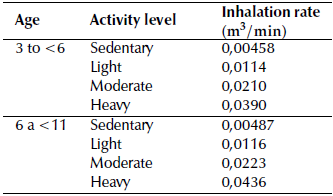
Source: EPA (2011)
Table 2 Descriptive statistics for average ventilation rate, unadjusted for body weight, while performing activities within the specified category (females by age category)
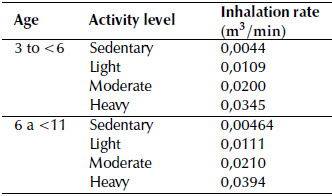
Source: EPA (2011)
The children activities considered herein are categorized as sedentary activity (sitting and standing), light activity (walking), moderate activity (fast walking and slow running), and heavy activity (fast running during sports classes). All these activities were recorded by gender and age range (three to five and six to ten years old) (Tables 3 and 4):
Table 3 Daily activity times for preschool and first grade (three to five years of age)
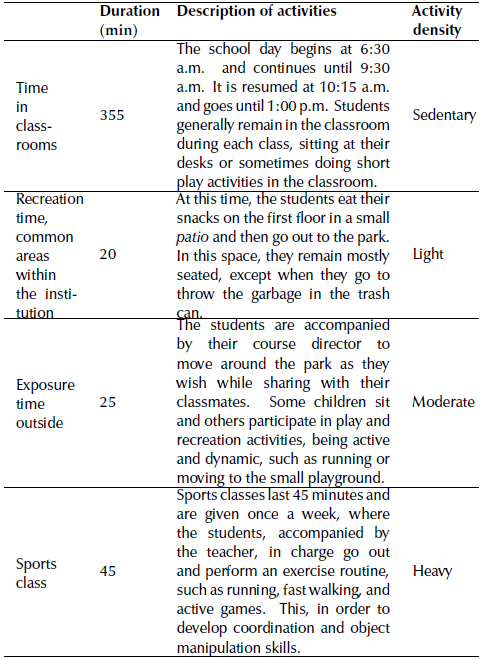
Source: Authors
Estimated potential doses
The PM2,5 dose was determined via Equation 1, with the inhalation volumes and the concentrations determined in situ. The following Figures display the daily doses by age and gender evaluated.
Figure 6 presents the behavior of the potential doses received in each analyzed group during the sampling period. The greatest dose values correspond to boys, in comparison with girls' doses during different activities, which is due to their slightly larger inhaled volumes. The trend observed in the Figures is similar to that of Figure 5a, implying that the PM2,5 concentrations in the children's environment are directly proportional to the potential dose that can be received, particularly during sports class day. Hence, heavy activity is the most significant parameter, even with less exposure time, due to the greater exertion required during the activity.
Preschool grade children reported high dose peaks on 12/02/2020 and 19/02/2020 for activities of heavy intensity, where the daily doses reached maximum levels (Figure 6a). On those dates, these children were exposed to an outdoors average hourly concentration of 14,3±0,2 µg /m3 during their sports class, ordinarily lasting 45 minutes. During this time, the inhalation rate increased significantly, so the children received a higher potential dose. For the whole sampling period, the potential inhaled doses of PM2 5 ranged from a maximum of 70,1 µg to a minimum of 21,6 µg.
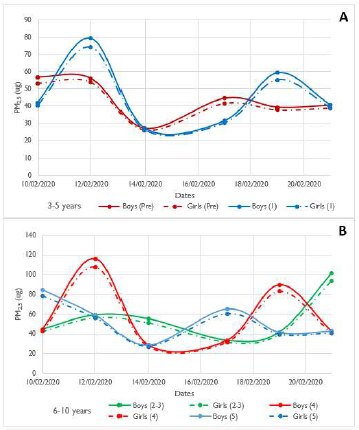
Source: Authors
Figure 6 Potential dose by gender and grade: a) three to five years old (preschool, first year), b) six to ten years old (second, third, fourth, and fifth years). Dashed lines for girls, continuous lines for boys.
A similar case occurred with older children (Figure 6b) on 12/02/2020 and 21/02/2020. They reported the highest peaks within an exposure time of 90 minutes, facing average hourly concentrations of up to 15 µg/m3 during sports class, reaching higher doses than first-year children (up to 102 µg), only because of higher environmental concentrations.
Figure 7 shows that boys and girls in the fourth grade received the highest calculated total dose for the entire sampling period (355 and 332,5 µg, respectively). This is followed by the second and third grades (both with equal doses, i.e., 334,9 and 314,4 µg, given that both sport classes take place on the same weekday).
Findings of respiratory symptoms in children
The survey was applied to 62 students (parental authorization was provided for their participation) in order to find out about any respiratory symptoms associated with PM2,5 pollution exposure. When implementing the ISAAC questionnaire, the following results were obtained for the symptomatology variables: cough, expectoration or phlegm, nasal congestion, nasal discharge, wheezing, dyspnea, and school absenteeism due to some respiratory disease (Figures 8 and 9).
The group with the highest incidence of respiratory symptoms corresponds to children three to five years of age (transition and first grade). This might be due to their higher respiration rate, lower body mass, and the incomplete development of their respiratory system, as their calculated doses were shown to be lower. Those with wheezing in the chest correspond to 27%, but few reported this symptom during or after physical activity. As for wheezing with flu symptoms (36%), children are more prone to contracting this type of symptoms dueto their weak immune systems. Some minors (27%) reported a sore throat when swallowing. The most common symptomatology (64%) is nasal congestion and discharge, which could be associated with exposure to PM2,5. Minors who have a dry cough at night which cannot be linked to a cold or chest infection amount to 36%, out of which 27% cough frequently, and that cough occurs when getting up or when they first go out to the street. Likewise, 18% of the minors reported an increase in coughing. According to the survey, no children reported dyspnea when performing physical activity, but a case of asthma (four years old) reported absenteeism in the group.
On the other hand, children between six and ten years of age (grades 2 to 5) reported dyspnea when performing physical activities such as running (10%), fast walking (6%), and walking (2%), which was directly proportional to the level of physical exertion. For this age range, a case of asthma (six years old) was found, with frequent school absenteeism. In light of these findings, within education institutions in this industrial area, but also in others with similar conditions, administrators and educators must perform a daily review of the air quality before allowing outdoor sports activities. Although this study found differences between the PM2,5 concentrations reported by the RMCAB and the in situ measurements, there is a similar trend between them than can be informative of the local situation. Sports activities should only be carried out during the appropriate days and times, so the students are not forced to receive exaggerated doses of pollutants. Institutions should also consider implementing local air quality monitors both indoors and outdoors in order to obtain more accurate information. Low-cost monitors are gaining momentum around the world, providing good high spatial and temporal resolutions regarding air pollution (Bulot et al., 2019; Wallace et al., 2021), and there are already applications in school environments (de Souza et al., 2017; Kazemi, 2018; Rogulski, 2018).
Finally, the ventilation of the premises must be ensured at all times. This is particularly relevant nowadays, when these institutions are resuming in-person activities after the national lockdown caused by COVID-19. A final recommendation would be the continuous cleaning of surfaces and floors in order to minimize dust accumulation and resuspension, and as well as to prevent fomite contagion.
Conclusions
This study dealt with the collection of PM2,5 samples in 48-hour periods for 15 days using Harvard impactors in Gimnasio San Valery (located in Puente Aranda), finding indoor concentrations ranging between 9,45±0,1 and 19,32±0,6 fg/m3. Outdoors concentrations varied, with minimum and maximum values of 7,28±0,1 and 15,60±0,3 µg/m3, respectively. Indoor concentrations were consistently higher than those outdoors. However, although the sources were not evaluated in this study, it is concluded that the intramural values are due to the resuspension of particles, the penetration of emissions from motor vehicles, insufficient ventilation in the area, and transport from local sources.
By using rubrics, it was possible to analyze children's daily activities according to gender and age range during the established school day. Theoretical inhalation rates were established from the EPA Exposure Factors Manual for sedentary, light, moderate, and heavy activities depending on physical effort.
Maximum and minimum potential doses were calculated for the evaluated period, finding a maximum dose of 102 f g for boys and 94,1 f g for girls. It is important to underline the need for limiting the air quality conditions under which sports activities must be performed. Institutions must complete daily validations of pollutant concentrations from the RMCAB to ensure that children are not exposed to elevated values.
Symptomatology variables such as cough, expectoration or phlegm, nasal and nasal discharge, wheezing, dyspnea, and school absenteeism due to respiratory diseases were consulted using a validated survey. The results suggested a larger prevalence of symptoms in students three to five years of age. However, dyspnea under different physical exertion levels is only reported for the higher grades.
Finally, the education sector must ensure appropriate ventilation and surface cleaning to guarantee air exchange rates that allow minimizing pollutant concentrations indoors. The implementation of new low-cost technologies may help to locally monitor air quality and ventilation conditions. This is of particular importance nowadays, when in-person activities have been fully resumed after the COVID-19 pandemic. This simple measure would reduce transmission rates, but also fine particle matter exposure from concentrations building up indoors.














